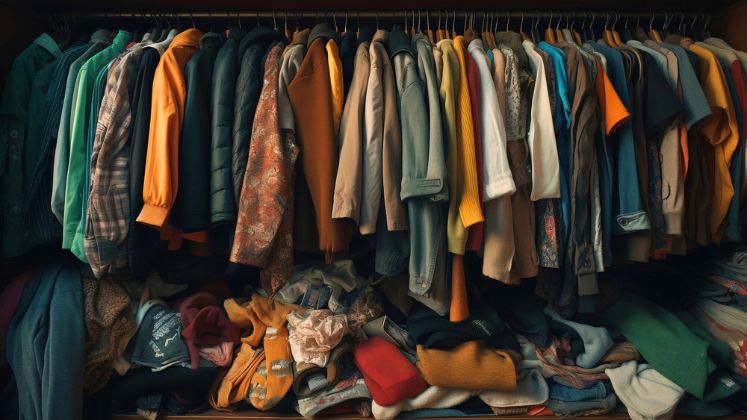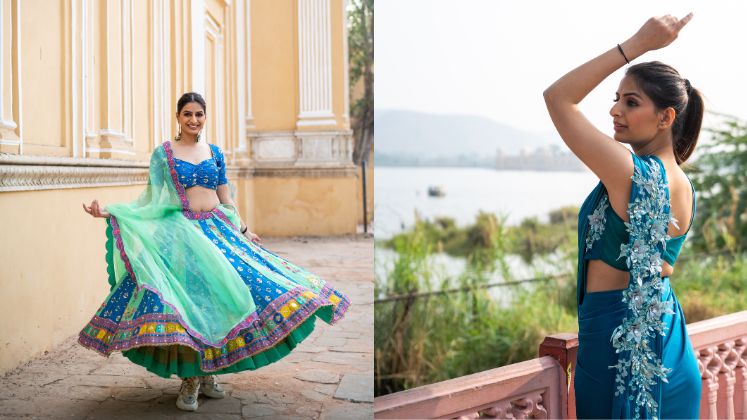The fashion system generates big waste, ranking amongst the planet’s most polluting industries. Over 100 billion garments are produced yearly, with only one per cent really getting recycled and 85 per cent being discarded in landfills or incinerators. No matter this, a rising world consumer demand for sustainability, with 60 per cent prioritising eco-friendly practices, is pressuring the commerce to undertake additional environmentally acutely conscious approaches.
As sustainability has turn into additional of a priority for buyers, the demand for choices has soared inside the kind of secondary fashion retail firms that embrace pre-owned, pre-loved, rental and thrift. These fashions, although not new, are selecting up in India as they supply buyers entry to fairly priced, well-crafted and high-quality garments and gear, empowering folks to flaunt helpful and stylish wardrobes whereas contributing to a additional sustainable fashion commerce. This newest improvement is pushed by quite a few parts, along with the rise of social media, the rising worth of garments and the rising inclination in direction of sustainability.
Considered one of many foremost causes influencing the popularity of rental fashion is consumer’s heightened curiosity in eco-friendly and cost-effective developments. Furthermore, technological developments have enabled corporations to broaden selections, altering patrons to renters.
The worldwide fashion rental market is projected to develop at a CAGR of 11 per cent from 2021 to 2031. Millennials are driving this shift, favouring renting for its cost-effectiveness and aligning with their want for fashion-conscious picks.
The impracticality of proudly proudly owning fairly a number of outfits, significantly expensive occasionwear, moreover impacts this rising improvement. Gen Z rejects societal consumption pressures, embracing acutely conscious picks with out compromising mannequin.
The rapidly rising world market for pre-loved and second-hand fashion is a testament to shifting consumer values within the path of sustainability, affordability and the necessity for distinctive and traditional devices. Whereas it’s tough to supply an precise decide because of decentralised nature of the market and ranging definitions of what constitutes pre-loved or second-hand fashion, estimates counsel that the market is substantial. In response to insights from ThredUP, a distinguished on-line consignment and thrift retailer, projections anticipate the worldwide second-hand apparel market to soar to a worth of US $ 64 billion by 2024, underscoring its impactful significance.
In India, whereas the panorama for pre-loved and second-hand fashion stays to be in its infancy compared with totally different areas, it’s steadily gaining flooring. Nonetheless, with rising consciousness about sustainability and affordability rising amongst Indian buyers, coupled with the rise of on-line platforms and marketplaces specialising in second-hand fashion, the market is predicted to broaden rapidly inside the coming years.
RENTAL FASHION
Globally, the second-hand apparel market was estimated at US $ 71,225.6 million in 2022 and is projected to broaden at a prolific CAGR of 14.8 per cent from 2022 to 2032, reaching a valuation of US $ 282,748.6 million by 2032. Publish-pandemic, seven well-liked resale and rental platforms like The Precise Precise, Depop, Lease the Runway, Vestiaire Collective and ThreadUP reached billion buck valuations.
On the subject of India, IMARC Group states that India’s second-hand luxurious objects market is predicted to reach US $ 1,060.8 million by 2028, exhibiting a compound annual improvement payment of 12 per cent (all through 2023 – 2028).
Presently, the product sales of used luxurious devices are experiencing a surge in India, pushed by the rising aspirations of youthful prospects and buyers in Tier-2 and Tier-3 markets.
No matter world indications of a slowdown inside the luxurious objects market, India-based Luxepolis, an online primarily based platform with an individual base of three.5 million, has reported over 80 per cent improvement in product sales this 12 months.
Throughout the house market, a multitude of omnichannel Indian fashion rental platforms, along with The Garments Rental, Flyrobe, Stage3, Lease It BAE, Lionise, Date The Ramp and Lease An Attire, have emerged inside the ultimate decade. These platforms objective to cater to the evolving preferences of updated buyers and tap into the rising improvement of sustainable and accessible fashion. Curiously, a whole lot of the distinguished producers inside the part acknowledge the significance of Gen Z buyers in shaping their future purchaser base, determining resale as a means to attract youthful buyers to their product line-up.
“After we started The Garments Rental nearly twenty years up to now, rental was sort of an unheard concept. People had a psychological stigma in opposition to pre-worn clothes, there have been issues about hygiene and confusion in regards to the technique. Nonetheless now, people are understanding the affordability of renting vs. purchasing for. The growth of social media has put a pressure on making an attempt good and by no means repeating garments. Purchasing for, drycleaning, and storing occasionwear has turn into expensive and that has given a improvement to fast fashion, pre-owned and rental fashions,” Shilpa Shankar Bhatia, Founding father of The Garments Rental, suggested Apparel On-line India in an distinctive interview.
| “The vital factor motivation driving Indian buyers to resolve on fashion rental over typical retail is undoubtedly affordability. Many consumers are pushed by the worth, the place they nonetheless aspire for a stand-out look nevertheless spending that loads on one-time placed on for only a few hours would not justify spending tonnes of money. As an illustration, a pleasing Indian lehenga at Aza or Pernia’s pop-up would possibly worth you upwards of wherever between Rs. 30,000 and Rs. 1.20 lakh, nonetheless within the occasion you would possibly rent the identical piece for Rs. 5,000 or Rs. 20,000, you would be tempted too.” Shilpa Shankar Bhatia Founding father of The Garments Rental |
Established in 2005, The Garments Rental is India’s first premium fashion rental trip spot. run by stylists and know-how entrepreneurs. It offers a curated guidelines of Indian and westernwear for ladies and men, alongside totally different courses comparable to pre-wedding and maternity robes in a variety of sizes and boasts of producers and designers comparable to Anushree Reddy, Rimple Harpreet, Manish Malhotra, SVA to name a few.
“Initially, folks rented primarily for affordability, nevertheless with rising consciousness, smart points have change right into a driving drive. The number of patrons selecting leases has notably risen. Societal attitudes within the path of fashion leases have shifted, with people overtly embracing and showcasing their rented seems to be like on-line and in society, tough earlier taboos associated to rental fashion,” Aanchal Saini, CEO, Flyrobe, Founder, Lease It Bae said.
| There are stringent requirements for inbound inventory, along with points for pricing, supplies and hues. Balancing developments and sturdiness is crucial since each product undergoes quite a few rental cycles, requiring alterations and rounds of drycleaning after each use. Regarding sourcing, we utilise every market selections and our owned inventory to ensure a varied and high-quality selection.” Aanchal Saini CEO, Flyrobe, Founder, Lease It Bae |
Flyrobe’s objective market primarily consists of fashion-conscious individuals who’re in search of a cheap and sustainable technique to entry a varied range of garments for quite a few occasions. The platform caters to people who admire the value of renting expensive and stylish outfits, whether or not or not it’s for explicit events, occasions or simply to experiment with utterly totally different varieties. Amongst the esteemed producers obtainable are Sabyasachi, Amit Aggarwal, Tarun Tahiliani, Marwar Couture, Gaurav Gupta, Dolly J, and so forth.
PRE-LOVED AND SECOND-HAND FASHION
By the use of the pre-owned luxurious objects market, the demographic comprises individuals who admire luxurious fashion nevertheless search a additional sustainable and accessible technique to it.
It is estimated that, in 2024, the rental fashion and pre-loved luxurious objects market is about to develop exponentially. Evaluation states that the spherical financial system will declare a severe stake inside the luxurious commerce inside the coming years.
The Luxurious One, brainchild of Divya Lalwani, was primarily based with the imaginative and prescient of making luxurious fashion additional accessible to a wider viewers, whereas promoting sustainability inside the commerce by offering a curated assortment of pre-owned luxurious devices.
“Clients, considerably millennials and Gen Z, are actively in search of sustainable and fairly priced choices. The will for on-line platforms has significantly elevated, showcasing a digital shift in consumer engagement. Furthermore, there is a rising appreciation for individualistic mannequin, emphasising uniqueness and the affordability of pre-loved fashion devices. These modifications mirror a broader movement within the path of acutely conscious and acutely aware consumer picks, shaping the dynamics of the second-hand fashion market,” Divya Lalwani suggested Apparel On-line India in an distinctive interview.
By extending the life cycle of these merchandise, the company contributes within the path of lowering the environmental affect associated to the manufacturing of newest devices.
Divya added, “Our take care of spherical fashion encourages a additional acutely conscious and accountable technique to consumption. We think about in the beauty of well-made and timeless objects that could be beloved by quite a few householders, aligning with the principles of sustainability and circularity.”
| Chanel was essentially the most well-liked pre-loved mannequin for resale in 2023, adopted by Hermes, Rolex, Louis Vuitton and Cartier. Probably the most well-liked courses for resale embrace baggage at 49%, adopted by watches at 21%, jewellery at 13%, garments at 9% and sneakers at 4%, consistent with Gugus, a platform that specialises in selling pre-owned luxurious objects. |
The mannequin stands out inside the aggressive second-hand and pre-loved fashion part via a curated assortment of luxurious devices, encompassing renowned producers comparable to Chanel, Louis Vuitton, Hermes, Gucci, Burberry, Rolex, Cartier and additional. Its principal class choices purses, adopted by footwear, shades, jewellery and gear and its dedication to creating luxurious attention-grabbing and approachable is mirrored in attractive and aggressive pricing on every new and pre-owned devices. Ensuring transparency and authenticity, every product undergoes a rigorous authentication course of.
| “The Luxurious One workforce targets to convey its shoppers the help of purchasing for merely the originals. We objective to fastidiously look at luxurious devices and redact ones that do not go our top quality checks. The workforce has expert professionals which have an unbelievable eye for vetting the entire parts necessary for declaring a product real. Our authenticity checks moreover include the merchandise being listed on the internet website being authorised by expert authenticators. We be sure that each little factor is true from stitching and labels to the usual of leather-based and the codes on the merchandise.” Divya Lalwani Founder, The Luxurious One |
Spoyl is one different such on-line platform the place prospects can purchase and promote pre-owned garments, gear and footwear. It offers a wide range of fairly priced fashion devices from every Indian and worldwide producers. Elanic is a peer-to-peer marketplace for buying and selling pre-loved fashion, magnificence and lifestyle merchandise. Clients can guidelines their gently used devices in the marketplace and patrons can uncover distinctive and fairly priced fashion finds. As quickly as As soon as extra is an online primarily based thrift retailer that offers a curated assortment of pre-owned garments, gear and residential decor devices. It focuses on sustainable fashion and offers a combination of traditional and trendy varieties.
| THE CLOTHING RENTAL COMPANY Product Courses And Pricing• Males’s Indian and Westernwear Rs. 3500 onwards • Ladies’s Westernwear Rs. 4000 onwards • Ladies’s Indianwear Rs. 4000 to Rs.30,000 • Pre-wedding XS , S, M, L, XL For women’s bust dimension: 32”, 34”, 36”, 38” Mens’ shirt dimension: 38, 40, Anushree Reddy, |
THRIFTING
Thrifting is the art work of in search of second-hand or pre-loved treasures, typically at thrift outlets, consignment retailers, storage product sales or flea markets. This train entails perusing an array of issues with the target of uncovering distinctive or budget-friendly gems. These days, the time interval ‘thrifting’ has surged in recognition, significantly on account of its sustainable and cost-conscious technique to purchasing garments, gear and residential items. It celebrates the enjoyment of uncovering hidden gems and the fun of securing implausible provides via the exploration of second-hand objects.
A rising improvement on Instagram and TikTok consists of an rising number of sustainable fashion influencers who actively work together in thrifting. Their content material materials usually choices the perfect bargains they’ve discovered or highlights their distinctive traditional finds, inspiring their viewers to embrace sustainable and budget-friendly fashion picks.
India moreover has its private legion of one-of-a-kind objects that add value to a minimum of one’s closet. Bygone Echoes (Instagram: @bygoneechoes) by fashion stylist Dennis Hauzel is one such platform that offers distinctive, covetable objects.
| BYGONE ECHOES: THRIFT STORE Product Courses And Pricing• Jackets, Coats, Sweaters, Garments, Skirts, Corsets, Trousers, Shirts and Tops for ladies and men Rs.500 to Rs.6000 |
Dennis possesses a discerning fashion for vibrant and daring prints that exude an eccentric however cool vibe. So it comes as no shock that his collections of thrifted garments promote out inside seconds of their launch, reflecting the widespread enchantment of his distinctive and stylish finds.
“The movement’s embrace is a testament to people awakening to the art work of respiratory new life into clothes, steering away from the throwaway custom. It mirrors a rising consciousness, with folks selecting a additional deliberate, acutely aware tempo in life and wardrobe picks,” Dennis Hauzel, Founding father of Bygone Echoes, suggested Apparel On-line India. “What’s considerably thrilling about this movement is its inclusive nature, inviting all people to be a participant, breaking away from the narrative dominated solely by conglomerates. It’s a shared journey in direction of sustainability inside the fashion market.”
| “My technique is spontaneous; there’s no set agenda other than selecting objects I genuinely like. Whether or not or not it’s a uncover from Sarojini, the lanes of Humayunpur or the small thrift retailer in my hometown, I’m drawn to objects that resonate with my fashion. I’m going the extra mile to minimise effort by selecting objects that meet the perfect necessities. From constructing to stitch top quality, I solely select up devices which are literally irresistible and it often takes a few week for me to produce, wash, promote and dispatch the devices.” Dennis Hauzel Founder, Bygone Echoes |
The authenticity of Dennis’ mannequin is its largest power. He doesn’t try to go well with a mould – what he releases is an actual reflection of his non-public fashion and this technique of staying true to himself has resonated positively with people, which is among the many foremost causes that set his mannequin other than the tons of inside the mix.
Alongside Dennis’ thrift retailer, there are tens and tons of of Indian corporations and influencers who’re working worthwhile thrift outlets on social media platforms with an lively consumer base. These corporations current Indian buyers with helpful and sustainable selections for looking for pre-loved and second-hand fashion, contributing to the spherical financial system and lowering waste inside the fashion commerce.
As an illustration, That Boho Lady (Kritika Khurana) is a popular fashion influencer who advocates for sustainable fashion practices, along with thrifting. She usually shares her thrift finds and styling suggestions on social media platforms like Instagram and YouTube. Residence of Second Hand is one different such on-line thrift retailer based in India that offers a curated assortment of pre-loved garments, gear and residential decor devices. It sources its merchandise from folks and resells them at fairly priced prices.
Instagram based Indian Thrift Retailer sells pre-loved garments, gear and lifestyle merchandise. It offers a variety of issues for ladies and men, along with garments, baggage, sneakers and jewellery, whereas Kabaad Ka Jugaad moreover offers a curated assortment of second-hand garments and equipment. It focuses on promoting sustainable fashion and ethical consumption practices.
THE CONSUMER
These days, the rental fashion market has turn into well-liked as buyers search additional eco-friendly and cost-effective methods to experience the latest developments. On account of technological advances, corporations have been able to broaden their technique and broaden their product selections and suppliers, serving to transform patrons into renters and unlock the potential fashion leases possess.
Millennials are reshaping their procuring habits, pushed by environmental consciousness and a necessity for fashion-conscious picks. Renting, favoured for its cost-effectiveness and elegance enchantment, aligns with millennials’ social media-driven custom of avoiding outfit repetition. The impracticality of proudly proudly owning fairly a number of outfits, significantly expensive occasionwear, fuels the popularity of leases, catering to millennials’ need for entry over possession. This cultural shift moreover celebrates pre-loved garments, tough fast fashion norms. On the same time, Gen Z, rejecting societal consumption pressures, embraces acutely conscious picks with out compromising on mannequin, marking a transformative interval.
In recognising India’s quite a few demographics, it is seen that certain fashion courses keep well-liked all through all areas. Flyrobe and Lease It Bae’s dedication to catering to quite a few consumer preferences is apparent of their inventory, with 20 per cent dedicated to region-specific merchandise. “There’s a notable demand for designer sarees inside the South, a improvement not as pronounced inside the North. This technique permits us to produce a curated selection that aligns with regional tastes, guaranteeing a additional personalised and associated fashion rental experience for our shoppers.” Aanchal outlined.
KEY GROWTH DRIVERS
The newest improvement is pushed by quite a few parts, along with the rise of social media, the rising worth of
garments and the rising inclination within the path of sustainability.
“As people turn into additional conscious about their environmental affect, the enchantment of second-hand fashion, with its emphasis on reusing and recycling, has significantly elevated. Furthermore, the rise of on-line platforms has carried out a pivotal operate. The comfort of buying and selling pre-owned devices via digital channels coupled with the consolation, choice and often discounted prices equipped by these platforms have contributed to their recognition amongst Indian buyers,” Divya said.
“The aspirational value associated to proudly proudly owning luxurious or high-end fashion devices has pushed the demand for pre-loved objects. Clients can now indulge of their love for renowned producers with out compromising on their dedication to sustainability.”
In the middle of the wedding ceremony season in India, the inclination within the path of shopping for new, trend-lead outfits will enhance, discouraging the repetition of ethnic purchases for a 12 months or two on account of placed on and tear, resulting in a financial strain. In response, metropolis Indians are an increasing number of adopting hassle-free renting as an aesthetic and economical risk, signifying a noteworthy cultural transformation and a forward step into the long run.
“The vital factor motivation driving Indian buyers to resolve on fashion rental over typical retail is undoubtedly affordability. Many consumers are pushed by the worth, the place they nonetheless aspire for a stand-out look nevertheless spending that loads on one time placed on for only a few hours would not justify spending tonnes of money. As an illustration: a pleasing Indian lehenga at Aza or Pernia’s pop-up would possibly worth you upwards of wherever between Rs. 30,000 and Rs. 1.20 lakh, nonetheless within the occasion you would possibly rent the identical piece for Rs. 5,000 or Rs. 20,000 rupees, you would be tempted too. Plus one needn’t worry about spending on dry cleaning it,” Shilpa outlined.
At Flyrobe, the rental value is roughly 10 per cent – 15 per cent of the M.R.P. Eg: If a lehenga sells at one lakh, you’ll rent it for 10,000 – 15,000.
“The rising consciousness of sustainable fashion practices has led buyers to resolve on rental as a additional eco-friendly risk, lowering the environmental affect of fast fashion. The need for choice and the pliability to placed on utterly totally different outfits for quite a few occasions with out the dedication of possession moreover drive the will for fashion rental. Furthermore, every Indian household coping with storage factors finds fashion rental attention-grabbing, as a result of it alleviates the need for storing generally worn garments. Moreover, the consolation of on-line platforms and the flexibleness they supply with regards to procuring, ordering and doorstep provide extra contribute to the popularity of fashion rental in India.” Aanchal mentioned.
MARKET PULSE
With a rising number of buyers adopting ethical and eco-conscious selections, the demand for second-hand fashion is projected to increase. Furthermore, the entry of newest players, ingenious enterprise fashions, and strategic collaborations contained in the sector signal a dynamic and evolving market.
Resale could possibly be a extremely efficient machine to attract new shoppers, significantly youthful and fewer affluent ones. Over time, as these shoppers develop mannequin loyalty and higher incomes, they’re extra more likely to commerce up. The true concern then for corporations is the potential for an additional individual selling their used merchandise if they do not work together in resale themselves.
Producers like French Connection, M&S, Lululemon, Hugo Boss and Burberry are responding to Gen-Z’s rising issues about carbon footprints by shifting within the path of rental and resale. In Europe, every H&M and Zara run their very personal buy-back schemes, with the latter making an attempt to produce repairs and resale suppliers too.
Spherical enterprise fashions encompassing rental and resale have the potential to take 23 per cent of the worldwide fashion market by 2030, as rising consumer consciousness of sustainability along with worth of dwelling pressures come to bear.
ADDRESSING CHALLENGES
The boundaries buyers uncover unappealing in rental fashion and pre-owned fashion are garment repairs, hygiene and top quality factors.
At Flyrobe, Lease It Bae and The Luxurious One, stringent top quality administration procedures are carried out every sooner than and after each rental transaction. When a product is added to the inventory, it undergoes a meticulous top quality look at to guage sturdiness. After rental and return, devices bear cleaning, sanitisation and one different spherical of top quality administration to deal with placed on and tear, guaranteeing sustained top quality for optimum leases. Every bit undergoes an entire authentication course of to make sure genuineness and alignment with the mannequin’s standing. The principle focus is on devices in fantastic or like-new scenario, prioritizing exclusivity and rarity. Educated consultants take care of refurbishment, addressing placed on or imperfections, adopted by authentication verification and rigorous top quality administration checks.
The part is furthermore grappling with quite a few operational challenges, with a specific emphasis on the complexities of inventory administration. These challenges embrace addressing circumstances the place a product is booked quite a few events with fastidiously spaced dates, guaranteeing nicely timed provide to every purchaser, managing customisations and allowing sufficient time between suppliers for refreshing or drycleaning.












